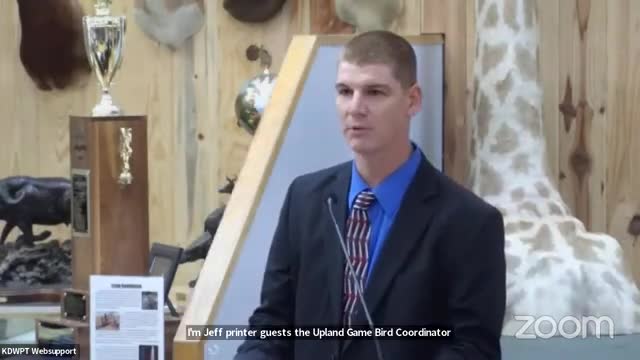Kansas Wild Turkey Populations Face Dramatic Decline
August 29, 2024 | Department of Wildlife & Parks, State Agencies, Organizations, Executive, Kansas
This article was created by AI summarizing key points discussed. AI makes mistakes, so for full details and context, please refer to the video of the full meeting. Please report any errors so we can fix them. Report an error »

In a recent government meeting, Kansas wildlife officials discussed the ongoing challenges facing the state's wild turkey population, including significant declines in abundance and the implications for hunting regulations. The interim turkey biologist presented data indicating that after a period of rapid growth in the 1980s and 1990s, turkey populations have been steadily declining since around 2010, coinciding with lower reproductive success rates.
Kansas is home to two subspecies of wild turkeys: the Eastern and the Rio Grande, with hybrid zones present in certain regions. Restoration efforts in the late 20th century had initially led to a resurgence in turkey numbers, but recent surveys show a troubling trend of decreasing populations across the state and similar patterns observed nationwide.
The biologist highlighted a collaborative research project with Kansas State University and the National Wild Turkey Federation aimed at understanding the factors contributing to this decline. The study will assess survival and reproduction rates statewide, focusing on various environmental factors, including habitat availability, predation, and potential diseases.
In response to the declining turkey numbers, the Kansas Department of Wildlife and Parks has implemented a turkey harvest strategy that adjusts hunting regulations based on population data. For the 2024 season, several units will see restrictions, including a complete closure of the fall turkey season. The biologist noted that the decision to limit hunting opportunities is based on a two-year assessment of harvest success rates, which did not meet the criteria for liberalization.
Commissioners raised questions about the role of predation and habitat loss in the decline of turkey populations. The biologist acknowledged that while predation is a significant factor, it is often a symptom of broader habitat issues. Ongoing research aims to provide a clearer picture of the challenges facing turkeys, including the impact of predators like raccoons and the potential effects of environmental toxins.
Public comments during the meeting included concerns about the introduction of agricultural runoff and its potential toxicity to wildlife, as well as anecdotal evidence regarding predation rates on turkey nests. The meeting underscored the importance of data-driven management decisions and the need for public understanding of the complexities involved in wildlife conservation efforts.
Kansas is home to two subspecies of wild turkeys: the Eastern and the Rio Grande, with hybrid zones present in certain regions. Restoration efforts in the late 20th century had initially led to a resurgence in turkey numbers, but recent surveys show a troubling trend of decreasing populations across the state and similar patterns observed nationwide.
The biologist highlighted a collaborative research project with Kansas State University and the National Wild Turkey Federation aimed at understanding the factors contributing to this decline. The study will assess survival and reproduction rates statewide, focusing on various environmental factors, including habitat availability, predation, and potential diseases.
In response to the declining turkey numbers, the Kansas Department of Wildlife and Parks has implemented a turkey harvest strategy that adjusts hunting regulations based on population data. For the 2024 season, several units will see restrictions, including a complete closure of the fall turkey season. The biologist noted that the decision to limit hunting opportunities is based on a two-year assessment of harvest success rates, which did not meet the criteria for liberalization.
Commissioners raised questions about the role of predation and habitat loss in the decline of turkey populations. The biologist acknowledged that while predation is a significant factor, it is often a symptom of broader habitat issues. Ongoing research aims to provide a clearer picture of the challenges facing turkeys, including the impact of predators like raccoons and the potential effects of environmental toxins.
Public comments during the meeting included concerns about the introduction of agricultural runoff and its potential toxicity to wildlife, as well as anecdotal evidence regarding predation rates on turkey nests. The meeting underscored the importance of data-driven management decisions and the need for public understanding of the complexities involved in wildlife conservation efforts.
View full meeting
This article is based on a recent meeting—watch the full video and explore the complete transcript for deeper insights into the discussion.
View full meeting
